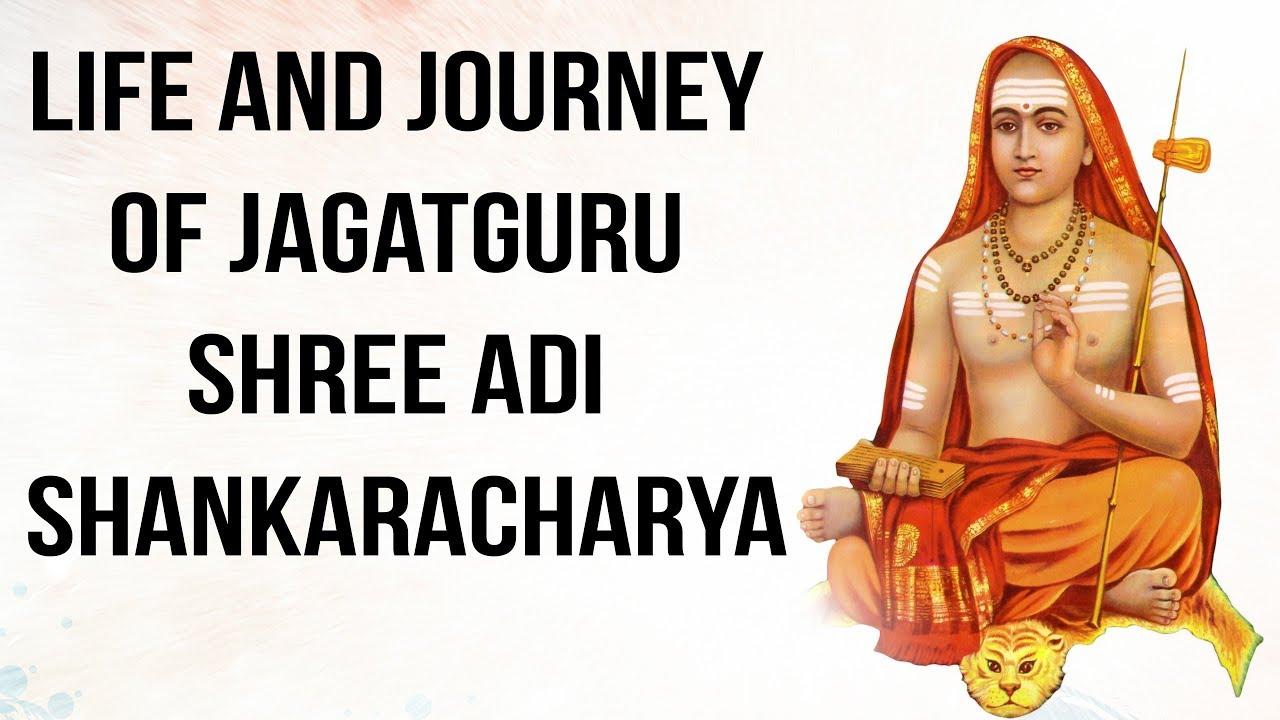Table of Contents
BIRTH
- Several different dates have been proposed for Shankara:
- 509–477 BCE:
- 44–12 BCE:
- 680 CE.
- 788–820 CE: This was proposed by early 20th scholars and was customarily accepted by scholars such as Max Müller, Macdonnel, Pathok, Deussen and Radhakrishna,and others.
EARLY LIFE
- Shankara, as he was known before becoming a great teacher, was born into a poor Brahmin family at Kaladi, present day Kerala, India.
- His parents, Sivaguru and Aryamba, offered their prayers to Lord Shiva, requesting the deity to bless them with a child. Their prayers were soon answered in the form of a baby boy. Hence, many consider Shankara as a reincarnation of Shiva.
- Shankara was educated by his mother as he lost his father when he was just seven. Aryamba played a key role in teaching Vedas and Upanishads to a young Shankara.
- Shankara’s upanayanam, the initiation into student-life, had to be delayed due to the death of his father, and was then performed by his mother.
SANYASI
- He was described as someone who was attracted to the life of Sannyasa (hermit) from early childhood. His mother disapproved.
- However his mother approved him to become a sanyasi. He then went in search of a guru, a young Shankara walked at least 2000 kilometers before meeting Govinda Bhagavatpada.
- Under Govinda Bhagavatpada’s guidance, Shankara studied ‘Gaudapadiya Karika’, ‘Brahmasutra’, Vedas, and Upanishads. To his teacher’s amazement, Shankara was able to master almost all the ancient scripts in a short time.
- During the course of his journey, Shankara‟s teachings were challenged by many philosophers and thinkers. He was even involved in a number of debates pertaining to Hinduism.
SANYASI
- From the age of sixteen to thirty-two Shankaracharya went forth, travelling across the length and breadth of ancient India bringing to the hearts of the masses the life-giving message of the Vedas. “Brahman, Pure Consciousness, is the Absolute Reality.
- The world is unreal. In essence the individual is not different from Brahman.” Thus by the statement “Brahma Satyam Jagan Mithya, Jeevo Brahmaiva Na Para“, he condensed the essence of the voluminous scriptures
GURU
- In those days ancient India was sunk in a quagmire of superstitions and scriptural misinterpretations. Degraded ritualism flourished.
- The essence of Sanatana Dharma, with its all-embracing message of Love, Compassion and the Universality of Humankind was completely lost in the blind performance of these rituals.
- Shankaracharya challenged various eminent scholars and leaders of various religious sects in vigorous disputes.
- They championed their own interpretations of the scriptures but the prodigious boy sage was easily able to overcome all of them and make them understand the wisdom of his teachings. These men of stature then accepted Shankaracharya as their guru.
MATHA
- Adi Shankaracharya founded four monasteries (mathas) – one each at the four cardinal points in India. Here are the four mathas founded by Shankara:
- Sringeri Sharada Peetham – This was the first monastery founded by Adi Shankaracharya. It is located at the southern part of India, along the banks of Tunga. Sureshvara was made the head of this matha as Shankaracharya moved on to establish other mathas. Sringeri Sharada Peetham advocates „Aham Brahmasmi‟ (I am Brahman) and was formed on the basis of Yajur Veda.
- Dvaraka Pitha – Dvaraka Pitha is located in the western part of India. Hasta Malaka, who came to be known as Hastamalakacharya, was made the head of this matha. Dvaraka Pitha advocates „Tattvamasi‟ (That thou art) and was formed on the basis of Sama Veda. MATHA
- Jyotirmatha Peetham – This monastery is located in the northern part of India. Totakacharya was made the head of this matha which advocates „Ayamatma Brahma‟ (This Atman is Brahman). Jyotirmatha Peetham was formed on the basis of Atharva Veda.
- Govardhana matha – Govardhana matha is located at the eastern part of India. The matha is a part of the famous Jagannath temple. Padmapada was made the head of this monastery which advocates „Prajnanam Brahma‟ (Consciousness is Brahman). It was formed on the basis of Rig Veda.
DEATH
- Adi Sankara is believed to have died aged 32, at Kedarnath in the northern Indian state of Uttarakhand, a Hindu pilgrimage site in the Himalayas.
- Texts say that he was last seen by his disciples behind the Kedarnath temple, walking on the Himalayas until he was not traced. Some texts locate his death in alternate locations such as Kanchipuram (Tamil Nadu) and somewhere in the state of Kerala
ADVAITA VEDANTA
- His Advaita (“non-dualism”) interpretation of the sruti postulates the identity of the Self (Atman) and the Whole (Brahman).
- According to Adi Shankara, the one unchanging entity (Brahman) alone is real, while changing entities do not have absolute existence.
- The key source texts for this interpretation, as for all schools of Vedānta, are the Prasthanatrayi–the canonical texts consisting of the Upanishads, the Bhagavad Gita and the Brahma Sutras.
ADVAITA VEDANTA
- Advaita Vedanta is based on śāstra (“scriptures”), yukti (“reason”) and anubhava (“experiential knowledge”), and aided by karmas (“spiritual practices”).Starting from childhood, when learning has to start, the philosophy has to be a way of life.
- Shankara’s primary objective was to understand and explain how moksha is achievable in this life, what it is means to be liberated, free and a Jivanmukta.His philosophical thesis was that jivanmukti is self-realization, the awareness of Oneness of Self and the Universal Spirit called Brahman.
- Shankara considered the purity and steadiness of mind achieved in Yoga as an aid to gaining moksha knowledge, but such yogic state of mind cannot in itself give rise to such knowledge.

























 WhatsApp
WhatsApp